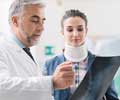‘Phantom’ Limb is a sensation in an amputee’s stump that generates the feeling that the amputated limb is still present.
Simran was busy playing golf. Various emotions flashed through her expressive face as she tried to concentrate. There are thousands of woman golfers in the contemporary world, but what made Simran special is that she is an amputee who is being trained to imagine playing golf with her missing limb as part of her treatment for phantom limb pain!
‘Phantom’ Limb is a sensation that makes an amputee feel that the limb removed is still present. Also referred to as ‘stump hallucination’ this near-real experience is highly subjective and is not triggered by external stimulus.S. Weir Mitchell’s first documented the phantom limbs while working with Civil War amputees at a Philadelphia hospital. He brought forth an account of his first hand experience with amputees, some of who were sure that they could still feel their amputated arms or legs. This generated a lot of curiosity in Mitchell’s days but today we know, only too well, that the sensation is far too common in the ‘land of the missing limbs’!
A study conducted by Vilayanur Ramachandran, who has done extensive work on phantom limbs using Q-Tips, revealed that certain areas of an amputated hand are mapped on different areas of the body. When the left side of the amputee’s chin is lightly brushed with a Q-tip, the person would report sensations in particular areas on the phantom limb.
This neuroscience expert believes that an existing, but hidden, neural circuitry linked to cortical remapping comes to life and is responsible for the phenomenon.
This sensation may often develop into a condition known as the Phantom Limb Pain (PLP). It is a condition, a serious one at that, which causes an amputee to experience chronic pain in the area where the amputed limb was once located. Victims have variously described the pain as aching, burning, or as though the ‘hand is being crushed in a vice’. These descriptions may not explicitly convey the angst of the sufferer. However, it is a well-known fact that the pain has the potential to interfere with social life.
Our understanding of the phantom limb sensation is derived from limited case studies, as direct physical study is not possible. Here are some interesting facts about phantom sensations:
On an average, 80% of amputees experience phantom limb sensations.
- The sensation may be felt immediately after an amputation. In some, it is felt months or years later.
- The nature of the sensation varies from patient to patient.
- In many phantom limb sensations tend to occur after an injury at the amputation site.
- The use of Prosthetic devices help in the management of phantom sensation
- Phantom limb sensation is not typically experienced by infants and toddlers
- For phantom sensation, limbs need not be severed or amputated.
- It also occurs in peripheral nerve injuries or after spinal cord injuries.
Several mechanisms are suggested that play an underlying role in generating phantom pain. It has been shown, by researchers, thatthe development of phantom limb pain has a lot to do with alterations in the way peripheral body regions are represented in the sensory cortex of the brain. In a phantom pain victim, a mismatch develops between the built-in map of the physical body within the brain and what it actually perceives.
Thus, the to and fro mechanism in this neural circuit undergoes a transformation. Nevertheless it is still unclear why this mismatch should result in pain.
Treatment
Phantom sensation and the ensuing pain is chronic, highly subjective and is most certainly not relieved by the existing set of treatments. Surgery carried out to relieve patients of the pain are known to do more harm than good.
Research now seeks to detect new origins of pain. Based on this concept, the focus has shifted from the site of amputation to the brain and new methods of chronic pain treatment have taken shape.
Ramachandran and Rogers carried out a trial in 1996, wherein people with phantom limb pain were requested to place their arms inside a mirror box. They saw the amputated stump mirror-reversed. On moving the stump inside the box, the patients were visually tricked into thinking that they were moving their amputated limb. For reasons still not clear, phantom pain was considerably reduced in these patients. Although not consistent this result indicates that there could be a correlation between the phantom pain and theloss of motor control to the limb, as well as loss of sensory input from it.
Flor’s group of researchers has discovered that an electrical prosthetic limb, that operates by signals emanating from the patient’s muscle, is capable of reducing the pain when used for prolonged periods.
According to Giraux and Sirigu, teaching patients to imagine the movement of their (paralyzed) arm in co-ordination with a virtual arm, moving on a screen before them, can rid them of their phantom limb pain.
Playing golf with the missing arm in the realms of one’s imagination also worked wonders.
Acupuncture and Magnetic therapy have also been used to treat chronic phantom limb pain. The nature of this chronic pain condition also demands that these patients undergo anxiety treatment which is often done by administering anti depressants.
All of the above treatment modes have, collectively, made the life of amputees a lot more bearable than what it was a few years ago.
Let us hope that in future, a better understanding of the mysteries of the human brain, and its role in pain, will help to usher in novel treatments for the sufferers.
Source-Medindia
Dr. REEJA THARU/L










